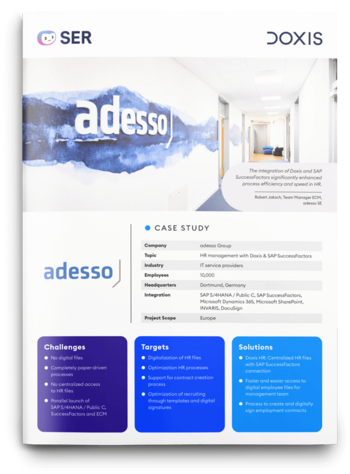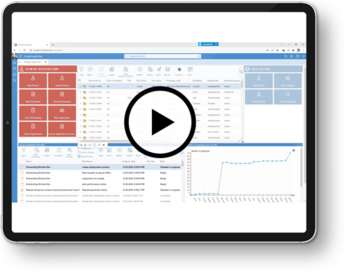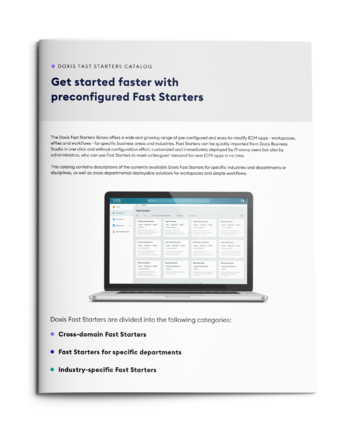SER Blog Innovation & Technology
HR transformation
Creating invoices and contracts, inviting applicants, checking timekeeping records – HR departments are mainly concerned with administrative tasks. As a result, creative and strategic HR issues are often neglected. Yet it is precisely these activities that are crucial to success in times of shortages of skilled workers, the great resignation, and the shift towards a market that favors workers. Nevertheless, it is often the HR department that is digitized last or is impacted by budget and staff cuts.
A fundamental HR transformation strategy is missing. In this article, we look at what it takes to successfully transform human resources work and how this can look.

The importance of transformation for HR
Transformation is a comprehensive change process that aims to realign organizations, roles, processes, and technologies. Transforming the HR department is about preparing human resources for the future and achieving the main objective – to find good employees and retain them in the company – through more efficient processes, leaner structures, automated routine tasks, and other measures.
A transformed HR department moves away from pure human resources management and instead creates opportunities for creative, personalized, and employee-centric services. In (digital) transformation processes, the focus is more on people than on technology (Harvard Business Review 2020). Transformation is a human resources issue, and HR transformation is therefore also the driver for transformation of the entire company.
Digital transformation instead of digitalization
Human resources departments need digitalization, for example, in the form of digital applicant management, to speed up the hiring process. However, digitalization alone is not enough.
The limits of digitalization in HR
For a long time, many companies have relied primarily on implementing new HR technologies in HR transformation in order to digitize paper-based documents. However, there was a lack of uniform processes, automation, and entirely new ways of working. The result: The same slow and inefficient processes are simply reproduced digitally.
Digitalization or technology alone does not lead to transformation. Real transformation means completely rethinking processes and adapting them to changing requirements. Automating administrative tasks and creating more space for creative tasks is on a par with promoting resilience. It is important that companies start to work early on being able to respond quickly and flexibly to such changes – without having to think of short-term emergency solutions that are not very efficient or sustainable.

adesso Group: Faster & easier HR management with SAP SuccessFactors integration
Discover how IT service provider adesso Group significantly enhanced process efficiency and speed in HR.
Read nowThe role of software solutions in HR transformation
Software solutions play an important role in HR transformation. They help to automate manual processes, optimize data management and document control, collaborate more efficiently, and conduct analyses.
Must-have software for HR
There are a number of tools and technologies that can help you transform your HR department. Many software solutions serve multiple functions. So with the right selection and combination you can get the most out of your HR activities. What is crucial, however, is that the softwares communicate with each another via interfaces and share a document base.
Human resource management system (HRMS) or human resource information system (HRIS)
An HRMS or HRIS provides the basis for managing all HR data. All employee information is stored centrally. The system helps you with data-driven strategies and enables you to transform your HR department based on informed decisions. You can also automate manual administrative tasks, make it easier to find information, reduce data entry errors, and strengthen compliance. One well-known system, for example, is SAP SuccessFactors.
Talent management and recruiting software
Talent management and recruiting software supports you in identifying, developing, and retaining talent in the company, and automates the application process from placing advertisements to screening applicants to hiring. This means your human resources department can put its energy into developing and implementing new and creative ideas for sustainable recruiting instead of time-consuming applicant management.
Learning and development platforms (LMS)
LMS systems provide training and development opportunities for employees. They help to retain skilled workers in your company and equip existing staff with the necessary know-how (for example on digitalization) so that they can master the challenges of the working world of tomorrow.
Time tracking software
This software makes it easier to implement the Working Hours Act. On the one hand, it helps you to fulfill your obligations under the Occupational Safety and Health Act. On the other hand, by recording working and project times, you can better allocate your resources.
Payroll software
This software automates the payroll process, including taxes, social security and deductions. The software ensures accuracy, compliance, and frees you to devote more time to strategic and creative HR work.
Document management system (DMS) and workflow automation
A DMS combined with Business Process Management (BPM) enables you to efficiently manage and automate HR documents and processes. This saves time and money, ensures secure and compliant storage of documents, accelerates HR processes, and improves transparency.
Employee self-service (ESS) and manager self-service (MSS) portals
ESS and MSS portals offer employees and managers the opportunity to independently manage their HR issues, such as vacation requests, pay statements, and performance reviews. This relieves the burden on the HR team and enables employees to quickly update their details. ESS portals are also a good way to promote employee engagement and a transparent communication culture in the company.
Employee surveys and feedback tools
Employee surveys and feedback play an important role in HR transformation. By actively involving your employees in the change processes, you ensure that the HR transformation meets the needs of your employees. You can also improve employee satisfaction and engagement through surveys and feedback tools.
Compliance and data security tools
These software solutions are used to ensure compliance with labor law, data protection regulations, and other legal provisions. With their help, you can build a compliance culture where all employees are aware of the relevant guidelines and risks. By doing so, you can prevent costly violations and ensure your ability to act.
Creating invoices and contracts, inviting applicants, checking timekeeping records – HR departments are mainly concerned with administrative tasks. As a result, creative and strategic HR issues are often neglected. Yet it is precisely these activities that are crucial to success in times of shortages of skilled workers, the great resignation, and the shift towards a market that favors workers. Nevertheless, it is often the HR department that is digitized last or is impacted by budget and staff cuts.
A fundamental HR transformation strategy is missing. In this article, we look at what it takes to successfully transform human resources work and how this can look.

Integrated intelligent recruiting processes
Discover in our product video how you can take your recruiting processes to a new level with Doxis.
Watch video nowBusiness apps instead of all-in-one software
In our personal lives, we are used to having an app for everything – new problem, new app. If an old app no longer meets the requirements, it is replaced. We also see this trend in companies. All-in-one software becomes a legacy system that requires considerable implementation effort, is expensive to maintain, and difficult to expand. That's why companies today prefer to use specialized applications that offer standardized workflows. With the trend comes a major stumbling block: a lack of connectivity. It is important that these business apps communicate with each other and have a single point of truth.
ECM platform with business apps
Our enterprise content management (ECM) system provides companies with a central information base that features a range of scalability options. Business apps – our more than 20 Doxis Fast Starters – are already included as standard, but can also be created or configured independently to meet very specific requirements. A variety of options for interfaces and standard interfaces, e.g. to SAP SuccessFactors, Microsoft, or Salesforce, expand the IT network to include essential third-party systems. They all share the same platform in the background as a digital archive and document management system, but they provide users with standardized and scalable workflows aligned with the department and business process.
Transforming the company with ECM
HR transformation is not just the responsibility of the HR department. The idea of transformation should drive all departments. An enterprise content management system with intelligent networking to all third-party systems is a crucial step in the transformation of the entire company.

Doxis Fast Starters Catalog
Take a look at our Doxis Fast Starters catalog and discover our preconfigured and easy-to-modify ECM apps.
Download catalog nowThe steps to successful HR transformation
Hey Doxi, how can I transform my HR?
With these four steps you can transform your HR department – and the entire company.
1. Analyze and assess existing HR processes
The first step is to examine existing HR processes and align them with the targeted conditions. Work with predefined KPIs and study each process closely to uncover problems and obstacles, but above all find potential for improvement. You will quickly find inefficient processes and stumble over recurring and obsolete work steps. If the time-to-hire is significantly too long, existing processes must be rethought and innovative ways of recruiting employees must be developed.
Once you analyze the current conditions, you will develop clear objectives for the digital transformation process.
2. Choose the right software solutions
After analyzing the targeted versus actual conditions, you select the suitable software solutions to transform your HR department. One focus should be on internal training management with predefined learning paths in order to address the staff shortage by making better use of existing resources. Good connectivity between the solutions is crucial.
Here are a few tips on what you should pay particular attention to when making your choice:
Usability: An intuitive user interface is crucial for high acceptance and active use of the new software solution.
Scalability and resilience: A good HR software solution can be easily adapted and expanded to meet the requirements of company growth, but also external influences such as new laws.
Integration options: Check whether the software can be connected to other systems and integrated in your existing IT infrastructure.
Workflows: True game changers in HR digitalization are the tools that allow you to automate recurring and tedious tasks, thereby freeing up time for creative activities.
Compliance: Particularly when processing personal data, compliance with all relevant regulations, such as EU GDPR and GoBD, is mandatory. Make sure that you rely only on certified partners.
Artificial intelligence: AI is the future. It drives the automation of processes, but also serves as a digital assistant and supports a range of tasks. For example, AI can answer questions about an employment contract, summarize an application, or suggest actions during a workflow.
3. Rollout and employee training
The rollout of new software always goes hand-in-hand with a change management process. It is important that all employees understand the need and, more importantly, the benefits of new processes and new technology as part of the HR transformation. Employees have to be notified about changes at an early stage through transformation and software training. Good change management provides support beyond the implementation process, for example, in the form of open question and answer sessions, experts for each team, or platforms to share ideas.
4. Monitor and adapt the HR transformation
Once software has been implemented, the HR transformation is far from complete. Now comes the important step of monitoring and adapting. Measure whether your defined objectives are being achieved and continuously improve your measures. To achieve sustainable transformation, you have to continuously monitor quality.
A central goal should also be to establish the change throughout the entire company. A culture of change is the key to being able to respond to future challenges in an agile and resilient manner.
What does the future look like in HR?
Artificial intelligence is finding its way into companies and will continue to play a major role in the future. AI is already being used today for smaller administrative tasks and in automation. But what possibilities does it hold for the future?
Support in selecting applicants
Companies are looking for new contacts for a job posting. And the ideal candidate is already in the talent pool. The AI tool sifts through old applicants (if they have agreed to be included in the talent pool) and suggests suitable people based on predefined criteria. Incoming applications are analyzed in the same way and an assessment is made by the AI tool. In the end, it remains only a recommendation, because only humans can “read between the lines.”
Continued training through personalized learning paths
The AI tool creates a learning path tailored to the job and based on the learning objectives agreed with line managers, and suggests videos and learning material from the learning platform. Even better: Using AI, all videos including lip movements are translated into the employee's preferred language. International companies only create company-wide learning videos once.
Ideal rosters for employees
Creating a roster was a pain for a long time. Every employee has their own preferred times, as well as vacation and illness-related absences. AI can use the data and, based on past data, write ideal work schedules that reflect employee requests and their hours available. Creating work schedules will soon be a task that only takes a few minutes.
HR transformation is a requirement for staying competitive and fit for the future. Essentially, it is an opportunity to give your company, your HR department, and your staff a boost through greater productivity, efficiency, and success.
SAP SuccessFactors meets Doxis
The latest digitization trends, laws and guidelines, and helpful tips straight to your inbox: Subscribe to our newsletter.
How can we help you?
+49 (0) 30 498582-0Your message has reached us!
We appreciate your interest and will get back to you shortly.




